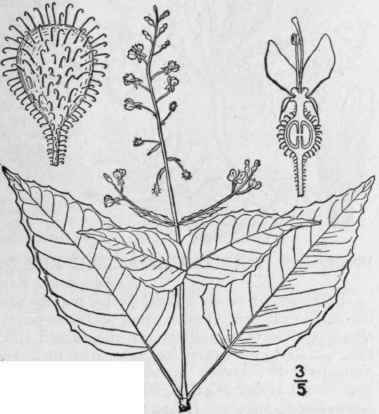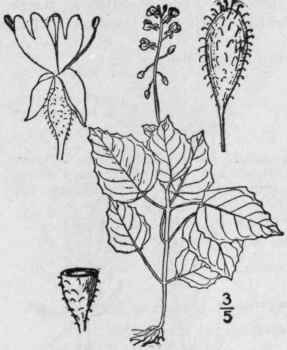20. Circača [Tourn.] L. Sp
Description
This section is from the book "An Illustrated Flora Of The Northern United States, Canada And The British Possessions Vol2", by Nathaniel Lord Britton, Addison Brown. Also available from Amazon: An Illustrated Flora of the Northern United States, Canada and the British Possessions. 3 Volume Set..
20. Circača [Tourn.] L. Sp
Pl- 9. 1753.
Low slender perennial herbs, with opposite petioled dentate leaves, and small white perfect flowers in terminal and lateral racemes. Calyx-tube hairy, slightly prolonged beyond the ovary, its limb 2-parted Petals 2, obcordate, inserted on the perigynous disk. Stamens 2, alternate with the petals; filaments filiform. Ovary 1-2-celled; united styles filiform; stigma capitate; ovules usually 1 in each cavity. Fruit obovoid, small, indehiscent, densely bristly with hooked hairs, 1-2-celled. [Named for Circe, the enchantress.]
Abous 8 species, natives of the northern hemisphere. Besides the following another occurs on the Pacific Coast. Type species: Circaea lutetiana L.
Plant 1°-2° high; leaves ovate; hairs of the 2-celled fruit stiff. | 1. | C. lutetiana. |
Plant 3'-8' high; leaves cordate; hairs of the 1-celled fruit weak. | 2. | C. alpina. |
1. Circaea Lutetiāna L. Enchanter's Nightshade
Fig. 3074
Circaea lutetiana L. Sp. Pl. 9. 1753.
Erect, branching, finely pubescent, at least above; stem swollen at the nodes, 1°-2° high. Leaves slender-petioled, ovate, acuminate at the apex, rounded or rarely slightly cordate at the base, remotely denticulate, 2'-4' long; pedicels 2"-4" long, slender, spreading in flower, reflexed in fruit; bracts deciduous or none; flowers about 1 1/2" broad; fruit broadly obo-void, nearly 2" long, 2-celled, densely covered with stiff hooked hairs, or rarely glabrous.
In woods, Nova Scotia to western Ontario, North Dakota, Georgia, Nebraska and Kansas. Also in Europe and Asia. Ascends to 2000 ft. in Virginia. Bindweed-nightshade. Mandrake. June - Aug. The specific name is from Lutetia, the ancient name of the City of Paris, France.
Circaea intermedia Ehrh. has thinner, strongly toothed leaves, some of them cordate, and ranges from Quebec to Michigan, New Hampshire and Ohio, and is recorded from Tennessee.


2. Circaea Alpina L. Smaller Enchanter's Nightshade
Fig. 3075
Circaea alpina L. Sp. Pl. 9. 1753.
Smaller, 3'-8' high, simple or branched, weak, glabrate, or pubescent above. Leaves ovate, slender-petioled, acute or acuminate at the apex, more or less cordate at the base, coarsely dentate, 1'-2' long; flowers about 1" broad; pedicels 1 1/2"-2" long, reflexed in fruit; fruit narrowly obovoid, 1-celled, about 1" long, covered with weak soft hooked hairs.
In cold moist woods, Labrador to Alaska, south to Georgia, Indiana, Iowa, Michigan and South Dakota. Also in Europe and Asia. Leaves thin, somewhat shining. Ascends to 6300 ft. in North Carolina. July-Sept.
Continue to:


